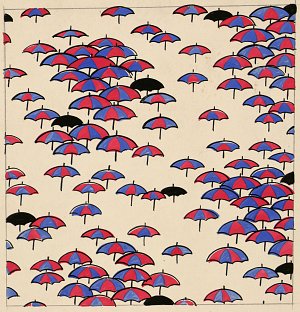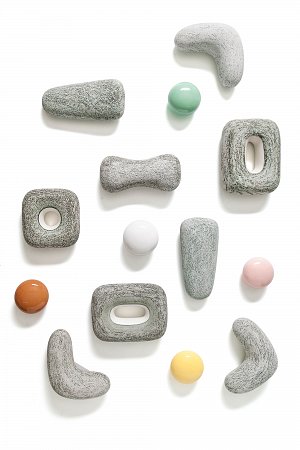Since its creation, the Musée des Arts Décoratifs has privileged the role of women as creators and in 1895, in the context of the debate on the place of women in society, founded the “Comité des Dames” (Women’s Committee) as an integral part of the institution.

Suzanne Lalique-Haviland, Study for a fabric with parasol motifs, 1920
Gouache on paper
© MAD, Paris
These female patrons and donors defended a moderate feminism not challenging the established order and the traditional family model, whilst striving for advances in social rights. They encouraged the artistic training of women, organizing competitions and exhibitions, and founding a school of decorative arts in 1897 that endured until 1988. Dora Maar and Charlotte Perriand both trained there.
The Comité des Dames is represented in the exhibition by a period room recreating the child’s bedroom in the Art Nouveau style shown in the Union Centrale des Arts Décoratifs pavilion at the Universal Exposition in 1900. The exhibition also features works by winners of the committee’s competitions in fields such as wallpaper, textiles, leather, furnishings, fans and ceramics.
Throughout the exhibition there are tributes to great figures who have played singular and historic roles in the applied arts, such as Princess Maria Tenisheva, who revived traditional Russian techniques, and the eminently eclectic creations of Suzanne Lalique-Haviland. Then come the women who took part in the historic avant-garde movements in the first half of the 20th century such as Hélène Henry, Sonia Delaunay, Elsa Schiaparelli, Charlotte Perriand and Eileen Gray.

Hella Jongerius, Blackparck sofa, 2007
Walnut, wool, cotton, linen, resin, metal
© MAD, Paris / Jean Tholance
The contemporary period has produced famous artists: Niki de Saint-Phalle, famous for her Nana figures; Maïmé Arnodin and Denise Fayolle, founders of Mafia, one of the first trend forecasting agencies; the Japanese fashion designer Rei Kawakubo (Comme des Garçons), whose furniture, created for her boutiques, is a blend of eastern and western influences; Matali Crasset, who questions traditional design typologies and practices; and Dutch creators such as Hella Jonguerius, who combines traditional crafts and industrial techniques.
The exhibition’s thematic sections highlight themes such as textiles, which since the 19th century has become a vibrant field of experimentation for artists such as Vera Szekely, whose boxes repeat the same elements with variations, and Sheila Hicks, whose works combining sculpture and tapestry revitalised the art of weaving in the early 1960s.
Jewellery is present throughout the exhibition, featuring the creations of Monika Brugger, who explores the theme of the thimble, Jacomijn van Der Donck, who works silver like lace, and Laurence Verdier’s wrapped objects.

Kristin McKirdy, Ceramic sculpture, 2016
Enamelled faience
© MAD, Paris / Jean Tholance
Ceramics, amply represented in the museum’s collections, is another domain in which women have expressed themselves particularly freely. Artists such as Guidette Carbonell, Suzanne Ramié, Jacqueline Lerat and Martine Damas have created sculptural forms with clay.
The exhibition ends on a humorous note with Vous avez dit femme?, in which artists such as Sophie Hanagarth, Valérie Delarue and Gabrielle Wambaugh express themselves ironically in several registers, evoking a certain vigour and forcefulness in their creative gestures and technical virtuosity.